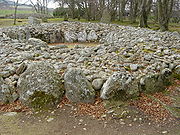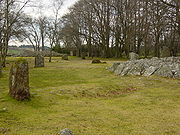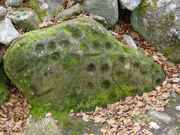
Clava cairn
Encyclopedia

Bronze Age
The Bronze Age is a period characterized by the use of copper and its alloy bronze as the chief hard materials in the manufacture of some implements and weapons. Chronologically, it stands between the Stone Age and Iron Age...
circular chamber tomb
Chamber tomb
A chamber tomb is a tomb for burial used in many different cultures. In the case of individual burials, the chamber is thought to signify a higher status for the interree than a simple grave. Built from rock or sometimes wood, the chambers could also serve as places for storage of the dead from one...
cairn
Cairn
Cairn is a term used mainly in the English-speaking world for a man-made pile of stones. It comes from the or . Cairns are found all over the world in uplands, on moorland, on mountaintops, near waterways and on sea cliffs, and also in barren desert and tundra areas...
, named after the group of 3 cairns at Balnuaran of Clava, to the east of Inverness
Inverness
Inverness is a city in the Scottish Highlands. It is the administrative centre for the Highland council area, and is regarded as the capital of the Highlands of Scotland...
in Scotland
Scotland
Scotland is a country that is part of the United Kingdom. Occupying the northern third of the island of Great Britain, it shares a border with England to the south and is bounded by the North Sea to the east, the Atlantic Ocean to the north and west, and the North Channel and Irish Sea to the...
. There are about 50 cairns of this type in an area round about Inverness. They fall into two sub-types, one typically consisting of a corbel
Corbel
In architecture a corbel is a piece of stone jutting out of a wall to carry any superincumbent weight. A piece of timber projecting in the same way was called a "tassel" or a "bragger". The technique of corbelling, where rows of corbels deeply keyed inside a wall support a projecting wall or...
led passage grave
Passage grave
thumb|250px|right|A simple passage tomb in [[Carrowmore]] near [[Sligo]] in IrelandA passage grave or passage tomb consists of a narrow passage made of large stones and one or multiple burial chambers covered in earth or stone. Megaliths are usually used in the construction of passage tombs, which...
with a single burial chamber linked to the entrance by a short passage and covered with a cairn of stones, with the entrances oriented south west towards midwinter sunset. In the other sub-type an annular ring cairn encloses an apparently unroofed area with no formal means of access from the outside. In both sub-types a stone circle
Stone circle
A stone circle is a monument of standing stones arranged in a circle. Such monuments have been constructed across the world throughout history for many different reasons....
surrounds the whole tomb and a kerb
Megalithic architectural elements
This article describes several characteristic architectural elements typical of European megalithic structures.-Forecourt:In archaeology, a forecourt is the name given to the area in front of certain types of chamber tomb...
often runs around the cairn. The heights of the standing stones vary in height so that the tallest fringe the entrance (oriented south west) and the shortest are directly opposite it.
Where Clava-type tombs have still contained burial remains, only one or two bodies appear to have been buried in each, and the lack of access to the second sub-type suggests that there was no intention of re-visiting the dead or communally adding future burials as had been the case with Neolithic
Neolithic
The Neolithic Age, Era, or Period, or New Stone Age, was a period in the development of human technology, beginning about 9500 BC in some parts of the Middle East, and later in other parts of the world. It is traditionally considered as the last part of the Stone Age...
cairn tombs.
Balnuaran of Clava

Bronze Age
The Bronze Age is a period characterized by the use of copper and its alloy bronze as the chief hard materials in the manufacture of some implements and weapons. Chronologically, it stands between the Stone Age and Iron Age...
cairns which lie close together in a line running north east to south west. The tombs at either end are of the passage grave
Passage grave
thumb|250px|right|A simple passage tomb in [[Carrowmore]] near [[Sligo]] in IrelandA passage grave or passage tomb consists of a narrow passage made of large stones and one or multiple burial chambers covered in earth or stone. Megaliths are usually used in the construction of passage tombs, which...
sub-type. The central cairn is of the ring cairn sub-type, and uniquely has stone paths or causeways forming "rays" radiating out from the platform round the kerbs to three of the standing stones. The cairns incorporate cup and ring mark
Cup and ring mark
Cup and ring marks or cup marks are a form of prehistoric art found mainly in Atlantic Europe and Mediterranean Europe although similar forms are also found throughout the world including Mexico, Brazil, Greece, and India, where...
stones, carved before they were built in to the structures. The kerb stones are graded in size and selected for colour, so that the stones are larger and redder to the south west, and smaller and whiter to the north east. All these elements seem to have been constructed as one operation and indicate a complex design rather than ad hoc additions.

Alexander Thom
Alexander "Sandy" Thom was a Scottish engineer most famous for his theory of the Megalithic yard, categorization of stone circles and his studies of Stonehenge and other archaeological sites.- Life and work :...
. He found that the ring was slightly egg-shaped with a complex geometry of circles and ellipses which could be set out around a central triangle, using sizes which are close to whole multiples of what he called the Megalithic yard
Megalithic Yard
A Megalithic Yard is a unit of measurement, about , that some researchers believe was used in the construction of megalithic structures. The proposal was made by Alexander Thom as a result of his surveys of 600 megalithic sites in England, Scotland, Wales and Britanny...
. While the geometry of the shape is generally accepted, the Megalithic Yard is more controversial.

